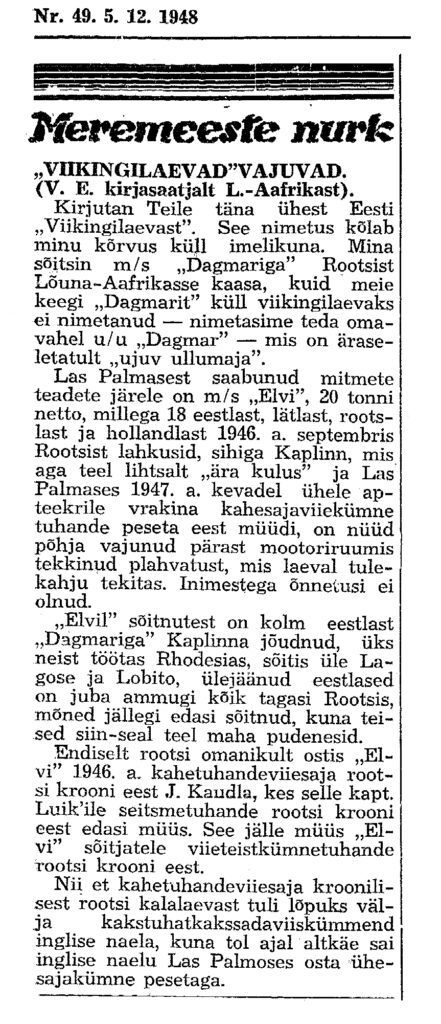Boats

“Viking ships” sink, Välis-Eesti, December 5, 1948
DAGMAR
The Dagmar was the first Viking ship to reach South Africa from Sweden. It was a 20-ton, 46-feet-long (14 meters), 20-feet-wide (6 meters) wooden fishing boat equipped with sails and a 24-HP engine. Jüri Kaudla organized the voyage and hired Aleksander Treilibs, a 32-year-old Latvian, as captain.
It’s not known from where the Dagmar sailed or how many people boarded at the outset. Similar to other Viking boats, plans were kept secret to avoid unwanted attention from the Swedish authorities and Soviet spies. According to newspaper reports, the Dagmar left Grebbestad, 93 miles (150 kilometers) north of Göteborg, on June 11, 1947. The boat encountered a storm in the North Sea that broke its mast. It was repaired in Ostend, Belgium.
The Dagmar reached the Spanish port of Coruña in early July. By then, the boat had weathered two more storms in the Bay of Biscay.
After leaving Coruña, the Dagmar encountered another storm that destroyed the engine. Under sail power alone, the boat reached Corcubioń, Spain, where a new cylinder head was cast, at no cost! The ship continued, reaching Las Palmas in the Canary Islands on July 19, where the crew planned to make additional repairs and buy diesel fuel. They also needed to hire a new captain because Aleksander Treilibs was mentally unstable. In Coruña, he had placed a lit rocket under the ship’s stove, fortunately not causing any serious damage. Treilibs was paid off and he left the ship.
The search for a new captain took more than a week. Eventually, Henry Claussen, a German, agreed to sail the Dagmar to South Africa for 100 English pounds. The journal Meie Tee reported that after leaving Las Palmas, the ship stopped in Freetown, the capital of Sierra Leone, in Luanda, the capital of Angola, and at Tiger Point on the southwest Angolan coast.
On November 2, 1947, the Dagmar sailed into the port of Lüderitz, German South West Africa (Namibia today). There were 16 people on board, including three Estonians from the Elvi who probably joined the boat in Las Palmas. According to Aja Kaja, a newspaper published on board (!), the ship’s safe arrival was a miracle, thanks to the extraordinary efforts of mechanics, electricians, and carpenters who were able to make new engine parts with their bare hands. Without them the journey would have ended prematurely. In addition, the boat’s 50-square-meter sails were poor quality and too small. The boat also ran aground a few times, fortunately without damaging the hull.
On December 5, 1948, Välis-Eesti published a story about the ship with the following paraphrased quote: “I sailed on the MS Dagmar from Sweden to South Africa, but we didn’t call her a Viking ship. We called her the UU Dagmar—the ujuv ullumaja—the floating madhouse.”
The journey had taken five months. It was a remarkable voyage for such a small boat. The last northern Europeans who had sailed to Lüderitz had arrived some two centuries earlier.
The Dagmar was sold for a high price of 2,800 South African pounds. Each passenger received 100 South African pounds, and they boarded a train to Cape Town to start their new lives. A wealthy farmer bought the Dagmar, thinking that it must be a good ship if it had sailed all the way from Europe. The boat was not suitable for local fishing conditions, however, and it soon sank.
Known crew and passengers:
- Captain Aleksander Treilibs (left in Las Palmas)
- Captain Henry Claussen (joined in Las Palmas)
- Jüri Kaudla, wife, and son, 8 months
- A. Rannala (published Aja Kaja newspaper on board)
- Jüri Truverk and Marta Jaago, his wife
- Karl Jänes, 47
